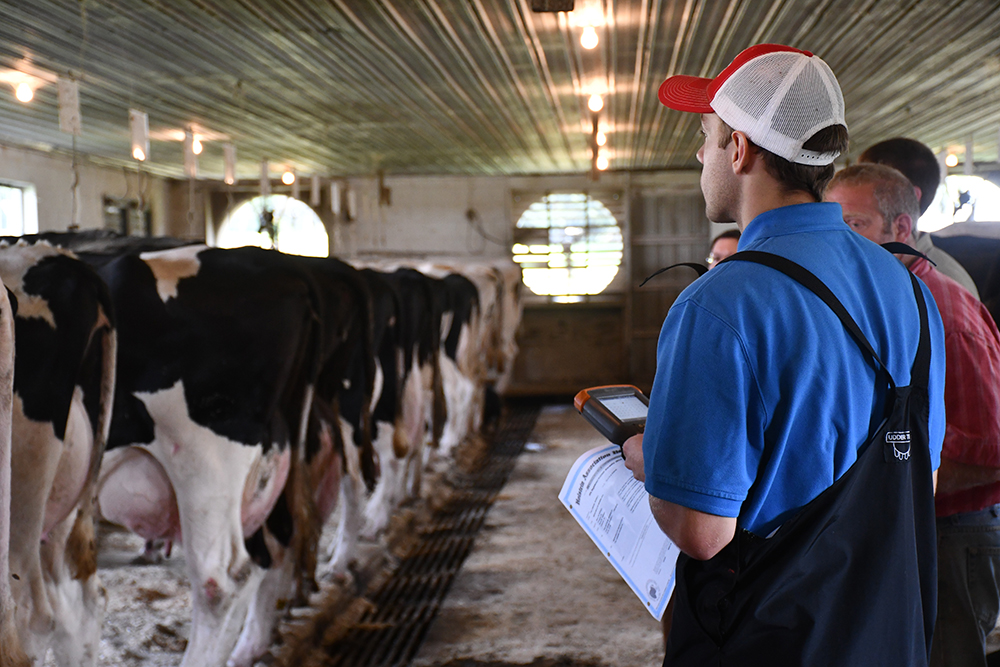Genomic testing begins when the animal owner decides to genotype an animal and takes a biological sample. Then, DNA samples and data flow through a process that results in genomic evaluations returned to the dairy producer, animal owner or organization marketing the animal.

Genomic Nominators are the link between genotyping labs, CDCB and those who request genomic evaluations on individual animals. A CDCB-certified Genomic Nominator collects initial information – like pedigree and birthdate – and sends it to CDCB. The nominator then facilitates the transfer of biological DNA samples to a CDCB-certified genotyping lab.
After genomic evaluations are calculated, CDCB returns results to the nominator, who forwards to the animal owner.
Genomic Nominators are generally breed associations, artificial insemination (A.I.) companies or genotype labs in North America or Europe. They are a critical conduit in genomic testing.
Nominators must meet CDCB quality standards (quick link to certification section below) to ensure the highest possible data integrity in the U.S. national cooperator database.
Genotyping laboratories examine an animal’s DNA through a physical sample, like hair follicles or a tissue sample, and compare it to the reference sequence (reference genome) to determine the specific alleles that individual has inherited for thousands of genetic markers. Labs transfer the genotypes to the CDCB database and summarize outcomes for the genomic nominator.
SNP (single nucleotide polymorphism)-chip genotyping technologies have evolved to cost-effectively genotype thousands of SNP markers. Higher density chips (at least 50,000 SNP) are used to genotype elite animals for potential marketing, mating and selection. Heifers being tested for herd management decisions are often genotyped with lower-cost, low-density chips (10,000 to 20,000 SNP).
Genotyping labs undergo a rigorous quality certification (quick link to certification section below) before they provide genotype results to CDCB to compute genomic evaluations.
Following data transfer and cross-checks, CDCB calculates the genomic evaluations, per established rules of publication and evaluation schedule. Official genomic evaluations for U.S. dairy cattle are calculated monthly and triannually – with traditional evaluations in April, August and December.
A series of checks ensure the genotype is assigned to the correct animal. Usable genotypes are extracted from the database, and genomic evaluations are calculated using advanced methodology proven by USDA, CDCB and other renowned institutions. Parentage verification and various genetic conditions are also tested and reported.
Quality evaluations must begin with quality data.
Genomic nominators and genotyping labs provide essential data into the National Cooperator Database managed by CDCB. This database is the world’s largest for animal data, and a sophisticated process is in place to ensure high data quality. This combination of data quantity and quality provides increasingly accurate predictions of genetic merit.
Nominators must meet quality standards and be certified by CDCB before they nominate animals into the National Cooperator Database.
Genotyping labs also undergo a rigorous quality certification before they provide genotype data to CDCB. Labs are required to be ISO certified (or equivalent) and provide Standard Operating Procedures to CDCB. All formats, files and genotyping results are carefully reviewed by CDCB. Labs passing certification can then provide genotypes for the National Cooperator Database.
The quality of genotypes and data received by the CDCB is reported monthly, based on a series of metrics. CDCB conducts annual audits of each participating nominator and lab.